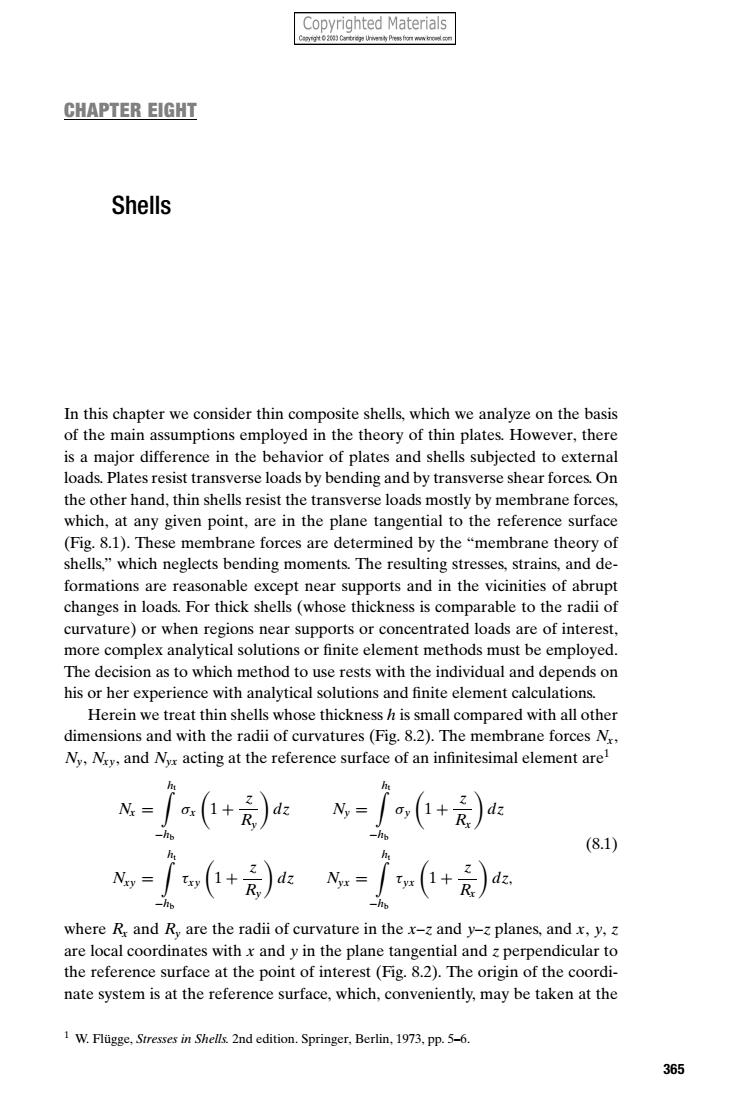正在加载图片...

Copyrighted Materials Cgo2 Cr Ue奇Pre女m CHAPTER EIGHT Shells In this chapter we consider thin composite shells,which we analyze on the basis of the main assumptions employed in the theory of thin plates.However,there is a major difference in the behavior of plates and shells subjected to external loads.Plates resist transverse loads by bending and by transverse shear forces.On the other hand,thin shells resist the transverse loads mostly by membrane forces, which,at any given point,are in the plane tangential to the reference surface (Fig.8.1).These membrane forces are determined by the "membrane theory of shells,"which neglects bending moments.The resulting stresses,strains,and de- formations are reasonable except near supports and in the vicinities of abrupt changes in loads.For thick shells (whose thickness is comparable to the radii of curvature)or when regions near supports or concentrated loads are of interest, more complex analytical solutions or finite element methods must be employed. The decision as to which method to use rests with the individual and depends on his or her experience with analytical solutions and finite element calculations. Herein we treat thin shells whose thickness h is small compared with all other dimensions and with the radii of curvatures(Fig.8.2).The membrane forces N, Ny,Nv,and Nyx acting at the reference surface of an infinitesimal element arel -0动- (8.1) where R and Ry are the radii of curvature in the x-z and y-z planes,and x,y,z are local coordinates with x and y in the plane tangential and z perpendicular to the reference surface at the point of interest(Fig.8.2).The origin of the coordi- nate system is at the reference surface,which,conveniently,may be taken at the 1 W.Flugge,Stresses in Shells.2nd edition.Springer.Berlin,1973.pp.5-6. 365CHAPTER EIGHT Shells In this chapter we consider thin composite shells, which we analyze on the basis of the main assumptions employed in the theory of thin plates. However, there is a major difference in the behavior of plates and shells subjected to external loads. Plates resist transverse loads by bending and by transverse shear forces. On the other hand, thin shells resist the transverse loads mostly by membrane forces, which, at any given point, are in the plane tangential to the reference surface (Fig. 8.1). These membrane forces are determined by the “membrane theory of shells,” which neglects bending moments. The resulting stresses, strains, and deformations are reasonable except near supports and in the vicinities of abrupt changes in loads. For thick shells (whose thickness is comparable to the radii of curvature) or when regions near supports or concentrated loads are of interest, more complex analytical solutions or finite element methods must be employed. The decision as to which method to use rests with the individual and depends on his or her experience with analytical solutions and finite element calculations. Herein we treat thin shells whose thickness h is small compared with all other dimensions and with the radii of curvatures (Fig. 8.2). The membrane forces Nx, Ny, Nxy, and Nyx acting at the reference surface of an infinitesimal element are1 Nx = ) ht −hb σx 1 + z Ry dz Ny = ) ht −hb σy 1 + z Rx dz Nxy = ) ht −hb τxy 1 + z Ry dz Nyx = ) ht −hb τyx 1 + z Rx dz, (8.1) where Rx and Ry are the radii of curvature in the x–z and y–z planes, and x, y, z are local coordinates with x and y in the plane tangential and z perpendicular to the reference surface at the point of interest (Fig. 8.2). The origin of the coordinate system is at the reference surface, which, conveniently, may be taken at the 1 W. Fl ¨ugge, Stresses in Shells. 2nd edition. Springer, Berlin, 1973, pp. 5–6. 365